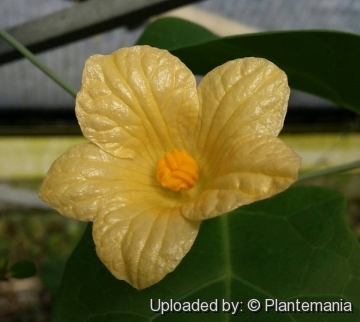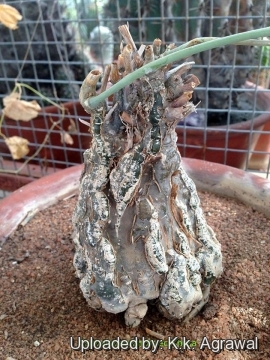Accepted Scientific Name: Cephalopentandra ecirrhosa (Cogn.) C.Jeffrey
Kew Bull. 17: 477 1964

Coccinia ecirrhosa (Cephalopentandra ecirrhosa) Photo by: Xero Sicyos
Origin and Habitat: Ethiopia, Kenya, Somalia, Uganda
Altitude range: 45-1090 metres above sea level.
Habitat and ecology: Cephalopentandra ecirrhosaSN|28065]]SN|28065]] grows in semiarid deciduous woodland and bushland on sandy soils
Synonyms:
See all synonyms of Cephalopentandra ecirrhosa
Common Names include:
ENGLISH: Cephalopentandra
Description: Cephalopentandra ecirrhosaSN|28065]]SN|28065]] is a very unusual perennial, deciduous, trailing herb to 1 m hight than develops with age a nice thick conical rootstock looking like a volcano with lava running down it, or a mountain shaped candle with melting wax coming down. The species epithet "ecirrhosa" means "without tendrils". It produces yellow flowers and very showy orange-red fruit. The Cephalopentandra is a popular caudiciform that becomes dormant in intense heat and cold.
Rootstock (caudex): Tuberous, subterranean or partly projecting above the soil as a prolate hemi-ellipsoid or conical somewhat reminscent of Dioscorea (not turtle-back look) to 20-60 cm in diameter and weighting more than 10 kg, furrowed, textured by multiple bumps and rounded tubercles with dark green and pallid papery, peeling bark.
Annual stems: 1 to several vining or scandent, to 1 m long, herbaceous glabrous at the base becoming thickened and woody with thin brownish papery bark.
Leaves: Subsessile, simple, amplexicaul, elliptic-cordate to ovate-triangular in outline, slightly apiculate, 30-90 mm long, 40-70(–120) mm broad, shallowly to deeply broadly to finely pinnately (3–)5–7-lobed, deep green to glaucous. Petiole 2-15 mm; glaucous, pinnately or palmate-pinnately. Lobes opposite, broadly rounded to finely dissected, 3–30 mm broad; blade narrowed to 3–42 mm between the lobes. Petioles 2–15 mm long, rarely longer in lowermost leaves.
Tendrils: Simple.
Flowers: Yellow or cream. It is dioecious (occasionally monoecious?) but has been reported that some plants change sex. As a regular cucurbit, female flowers are recognizable by the base of the flower looking like a miniature fruit, while the male flowers have a regular stem.
Male flowers: Solitary or paired, Peduncle 1.7 - 2.5 cm. Hypanthium cylindrical below, expanded and campanulate above, 7 - 10 mm. Sepals triangular-lanceolate, 2 - 3 mm long. Petals pale or greenish yellow 5, united in the lower part, 12-28 mm long, 8 - 13 mm broad. Stamens 3, free.
Female flowers: Solitary 10–19 mm long. Peduncle 9-10 mm broad. Hypanthium cylindrical, ca. 7 mm long, Sepals and petals like those of male flowers.
Fruits: Ellipsoid, 80 mm long and 40 mm in diameter, green with paler stripes or markings, orange-red when ripe, smooth and glabrescent. Pedicel 0.7–2.5 cm long.
Seeds: Many. 6 x 5 x 2 mm, black, rough with small rounded warts.
Bibliography: Major references and further lectures
1) Klaus Kubitzki “Flowering Plants. Eudicots: Sapindales, Cucurbitales, Myrtaceae” Springer Science & Business Media, 10/dic/2010
2) Urs Eggli “Illustrated Handbook of Succulent Plants: Dicotyledons” Springer Science & Business Media, 2002
3) C. Jeffrey & M. Thulin “Flora Somalia” Vol 1 1993 [updated by M. Thulin 2008]
4) C. Jeffrey “Flora of Tropical East Africa” 1967
 Coccinia ecirrhosa (Cephalopentandra ecirrhosa) Photo by: © Plantemania
Coccinia ecirrhosa (Cephalopentandra ecirrhosa) Photo by: © Plantemania Coccinia ecirrhosa (Cephalopentandra ecirrhosa) Photo by: K.k. Agrawal
Coccinia ecirrhosa (Cephalopentandra ecirrhosa) Photo by: K.k. AgrawalCultivation and Propagation: Cephalopentandra ecirrhosaSN|28065]]SN|28065]] grows relatively easily and doesn't produce as many stems and leaves as other cucurbits, making its management easier.
Growth rate: It grows well, though very slowly, but it possible to increase the speed of growth to some extent by providing adequate amount of water, warmth, and fertilizer during the active growing season, but it’s susceptible to rotting if too wet.
Potting medium: Since roots are quite succulent, use a slightly acidic cactus mix or add extra perlite, vulcanite or pumice to regular soil potting soil. A gritty, very free-draining compost is suitable, and clay pots help the plants to dry out between watering. It like pots with generous drain hole, re-pot every 2 years.
Frost tolerance: Due to its African origin keep warm in winter, the minimum safe average temperature is 15°C, although it can go lower for short periods. It can be grown outdoors in frost-free climates, need anyway to kept above 10°C and dry in winter.
Exposition: It likes a sunny position, but avoid direct blasting sun in summer. Keep the caudex in the shade.
Watering: It should be watered regularly when it begins to produce leaves in spring/summer and kept drier in Winter. Like most caudiciform cucumbers it likes lots and lots of water during warm and hot weather, and is accustomed to growing under other plants, vining up into them. Make sure after watering, that the soil is actually wet. Many potting soil mixes will have only the surface wet, with water running down the outside of the root ball, and most of the soil dry. Run your finger into the soil 15 minutes after watering to check. Too high or too low temperature will induce dormancy.
Maintenance: Repot every two years.
Propagation: Seeds or cuttings.












